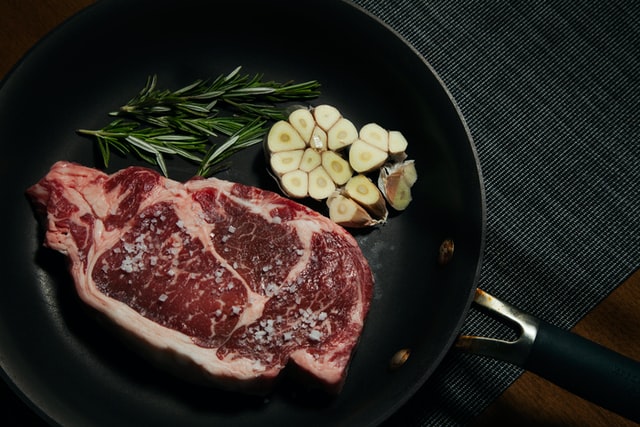Here at the One Warwick Park Hotel, we like to encourage our guests to bring out their inner carnivore in our delightful sister restaurant, aptly named STEAK for our signature dish. Our chefs are dedicated to creating steak dishes (with other menu items for vegan and vegetarians of course) that will knock your socks off.
Steak in all its variations has been a favourite of the British foodie for centuries, with the meat gaining prominence as a dish for the wealthy during the Norman conquest. As it is served today it is a hotly contested dish with variations on recipes, cooking times, and sauces in each country and often even in each family. As for what we can all agree on, there is no treat quite like a perfectly cooked steak served with delicious side dishes and various sauces.
The History Of Steak Dinners
The cut of steak is generally considered to be a Scandinavian invention that originated in the 15th century. From there the beef steak migrated to Florence in Italy and around the world to become the iconic dish that it is today. While this is the most widely accepted beginning of the steak, different cuts were popularised at different periods in history, evolving over the decades into its current incarnation. The appearance of this dish may look fairly uniform in the UK but may differ widely from the preferred way of serving the dish in other countries, such as in Japan where steak is often grilled by the customer at the table in ‘yakiniku’ style. One of the more unusual steak dishes is steak tartare, which is an infamous French dish where thinly sliced raw steak is served in a marinade. A poached egg is often used as a topping for the dish, which is often served with toasted bread. America is often considered to be the modern home of steak, with restaurants specialising in the dish appearing all over the country. For instance, many restaurants on the east coast are known for ‘Surf and Turf’, a uniquely American dining experience where red meat is served with seafood.The Steak
The particular part of the cow that is used for the steak meat can drastically alter the taste of the dish. Butchers and suppliers are often very competitive when it comes to the quality and taste of each cut of meat. Western meat tends to be leaner with more muscle, whereas the infamous Japanese beef tends to be prized for a marbled effect in the meat from the fattier cut. When ordering steak, there are a few key cuts that are important to remember in order to understand what the meat will likely look like:- Sirloin – This steak is cut from the back muscle attached to the spine and often has a deeper meaty taste than other cuts of steak, and as such is often paired with very flavoursome sauces with garlic and onion as they will not overpower the steaks natural taste.
- Ribeye – The steaks are cut from around the ribs of the animal and can be served with the bone in (Known as rib steak) as well as with the bones removed (traditional ribeye steak). This cut has a high-fat content and is known for being tender, making it a restaurant favourite.
- Fillet – A fillet steak is cut from the end of the tenderloin; it is lean and thicker cut than other cuts of steak. This steak is also known as the fillet mignon to those who prefer to be specific.
When these steaks are sold in a restaurant, they are often sold at different weights depending on the cut and taste of the meat. Make sure to remember that the weights shown are the uncooked weight of the meat, so the actual size of the dish may vary. If you are unsure about which weight would best suit you, asking the waiter which of the sizes they would recommend would be a good idea.
Side Dishes
Steak and chips is the most iconic version of the steak dinner that is cooked and loved all over the world. However, there are a variety of side dishes that are commonly served with this dish such as:- Dauphinoise potatoes
- Potato salad
- Grilled mushrooms
- Coleslaw
- Onion rings
- Leafy salad
How Rare Should Your Steak Be?
The discussion on how to cook a steak perfectly is hotly contested, with many having a specific preference. If you are ordering a steak in a restaurant, the ways a chef can cook a steak generally fall under four categories, well-done, medium rare, rare and blue rare which is often close to raw. Different cuts of steak will have different cooking methods and times so it is often best to leave how rare you want your steak to the discretion of the chef, as they will likely have a good idea of what works for the meat. The sauces added can also influence how rare your steak should be, as light butter sauces go well with a rare steak and more rich sauces such as a blue cheese sauce can work well with a medium-rare sirloin.Sauces
While steaks are delicious served as they are, sometimes a helping of a delicious sauce for the dish can make the meal unforgettable. There are many tried and tested sauces that are often used on a steak, but many chefs or restaurants will have their own unique version in order to make their dish unique. Here are a few of the most common sauces used on steaks:- Peppercorn
- Blue Cheese sauce
- Béarnaise sauce
- Chimichurri
- Butter and garlic sauce
- Red wine jus

